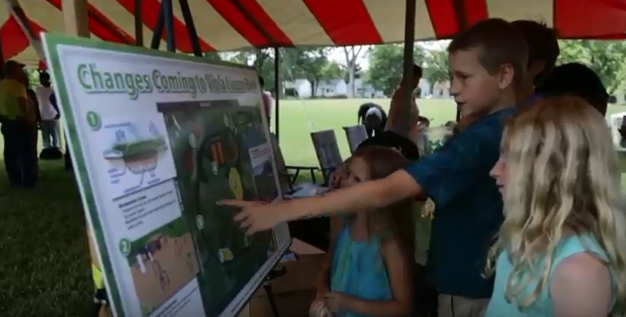After a $1 million investment from the City of Detroit, the new redone Viola Liuzzo Park is ready.
Named in honor of a fallen Detroit civil rights champion, the park on the Detroit’s northwest side has an array of new features and equipment, including three beautiful bioretention gardens. In addition, a type of green stormwater infrastructure enriches the appearance of the park and reduces stormwater runoff in the surrounding neighborhood.
Liuzzo, a Detroiter and mother of five, was shot and killed in March 1965 as she and fellow civil rights activists returned from a rally in Montgomery, Alabama. The City of Detroit dedicated Liuzzo Park in her honor in 1982.
“This park has a deep meaning in Detroit and honors Viola Liuzzo and her sacrifice,” says Mayor Mike Duggan. “We made the kind of investment in Liuzzo Park – and 39 others – that our residents deserve.”
Among the capital improvements at Liuzzo Park are:
- New playground and equipment
- Picnic facilities
- 2 pickleball courts
- Fitness equipment
- New walkways and benches
- New landscaping
Liuzzo Park is the final project to be dedicated of the 40 Neighborhood Parks Initiative that Duggan announced in 2016. Improvements to those 40 parks were paid out of nearly $12 million in bond money that CFO John Hill discovered had gone unspent for decades.
For those of you interested in learning more about the bioretention gardens here goes.
The Detroit Water and Sewerage Department (DWSD), working with the Detroit Parks and Recreation and General Services departments, and the Viola Liuzzo Park Association, recognized the opportunity to integrate innovative green stormwater infrastructure features into the park’s redesign as a way to beautify the park while improving Detroit’s stormwater management.
Green stormwater infrastructure is an approach to managing stormwater that uses the natural processes of soils and plants to soak up water where it falls before it can enter and overwhelm the city’s combined sewer system. DWSD constructed three bioretention areas in Liuzzo Park to treat and infiltrate stormwater from the streets and sidewalks. The bioretention features include plants which complement the neighborhood and are sustainable.
The bioretention areas at the park are expected to retain an average of 280,000 gallons and detain 710,000 gallons of stormwater volume annually.
Some of the plants selected in the planting plan for the bioretention areas included: Purple Coneflower, Lime Rickey Coral Bells, Obedient Plant, Gerald Darby Iris, Black-Eyed Susan, Rising Sun Redbud, Little Bluestem, Yellow Twig dogwood, and Fragrant Sumac.
For more information on Detroit’s revitalized parks, click here. To learn more about Detroit’s efforts to improve stormwater management, click here.


